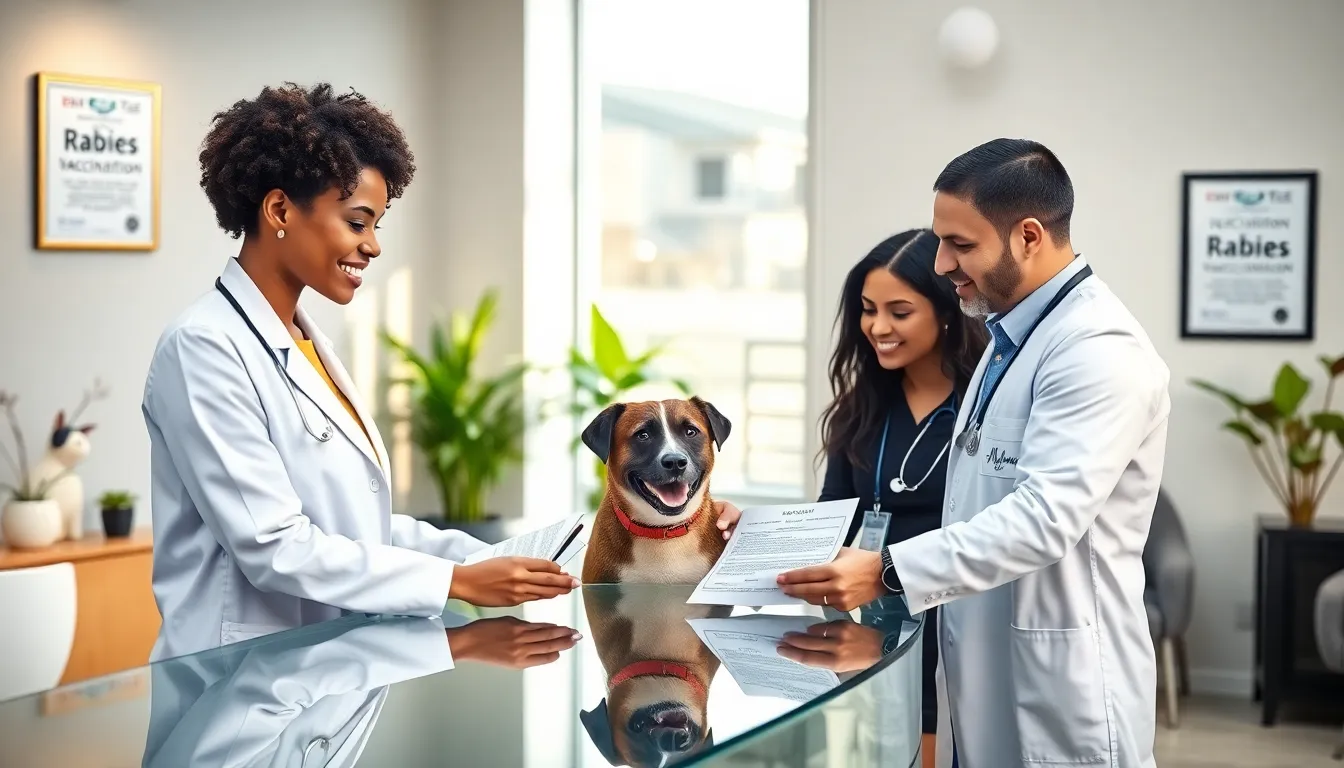Have you ever tried to convince your dog that getting a rabies vaccination is a good idea? Spoiler alert: it won’t work. But, once your canine friend is vaccinated, you’ll need that dog proof of rabies vaccination form to prove it. This essential document isn’t just for show: it’s a critical piece of paperwork that can save you a lot of hassle. In this guide, we’ll jump into everything you need to know about rabies vaccination requirements, the importance of the vaccine, and how to obtain that all-important proof. So grab your pup, and let’s go on this informative journey together.
Table of Contents
ToggleUnderstanding Rabies Vaccination Requirements

Rabies vaccination is mandatory in most states across the US. The requirements can vary significantly depending on where you live, but generally, dogs must receive their first rabies shot at around three months of age. Following this initial vaccination, a booster shot is usually required every one to three years, again depending on local laws and the type of vaccine used. Having your dog vaccinated not only protects your pet but also satisfies legal requirements that keep the community safe.
It’s crucial to check with your local regulations, as some regions have stricter timelines and requirements based on rabies prevalence. Well, if you didn’t know that, then consider this your wake-up call. Ensuring your dog is vaccinated against rabies is a way of fulfilling your responsibility as a pet owner.
Even if your dog is the world’s most lovable pooch, rabies is a serious disease that can be transmitted through bites from infected animals. So, yes, that sweet furball curled up on your couch could potentially be a ticking time bomb if they aren’t vaccinated. Most vet clinics are happy to fill you in on the specific regulations for your area, providing peace of mind and prevention against any potential rabid encounters.
Importance Of Rabies Vaccination
The importance of rabies vaccination cannot be overstated. This vaccine protects not only your dog but also public health. In fact, rabies is a viral disease that once contracted, is almost always fatal. Once symptoms appear, the prognosis deteriorates rapidly, think of it as nature’s way of delivering a highly undesirable wake-up call.
When a dog is vaccinated, it builds immunity against the virus, providing a safeguard that minimizes exposure risk. This is especially crucial in areas where wildlife may pose a threat, like raccoons, bats, and skunks, all of whom can be rabies carriers.
By having your dog vaccinated, you’re safeguarding them from these potential hazards. And let’s be real: no one wants to fancy a world where their dog has to stay inside like a vampire during daylight hours.
So while it may seem like a hassle to march your furry friend to the vet for that shot, it’s crucial. Not only does it keep your dog healthy, but it also maintains community safety, allowing all pups to roam freely without the threat of rabies hanging over them.
Components Of A Rabies Vaccination Certificate
A rabies vaccination certificate isn’t just a piece of paper: it’s a document that provides critical information about your pet’s vaccination status. Here are the main components that you should expect to see:
- Owner Information: Your name and address, so people know who to thank (or blame) in case your dog decides to run away.
- Dog’s Information: This includes your dog’s name, breed, color, and any distinguishing features. You don’t want someone mistaking your Rottweiler for a Chihuahua.
- Veterinary Clinic Details: The name, address, and phone number of the vet that administered the vaccination. This information helps verify the authenticity of the certificate.
- Vaccination Details: The date your dog received the vaccination and the due date for its next booster shot. You wouldn’t want the vet calling you at midnight for a reminder, would you?
- Registrar Signature: A signature from a licensed veterinarian, confirming the vaccination. It’s like getting a seal of approval for your pet.
When you receive this form, be sure to keep it in a safe place. Lost documentation can lead to a series of hurdles you’d rather not face later, especially when it comes to travel or dog parks.
How To Obtain A Dog Proof Of Rabies Vaccination Form
So you’ve finally managed to get your dog vaccinated, congrats. But wait, how do you actually get that coveted dog proof of rabies vaccination form? Here’s the straightforward process:
- Visit Your Veterinarian: The first step usually involves a trip to your vet. When visiting, request they provide a rabies vaccination certificate. Most reputable veterinary clinics will have standard procedures to issue this form immediately after vaccination.
- Check Your Vet’s Records: If you already had your dog vaccinated in the past and didn’t receive a certificate, don’t fret. Call your vet: they can usually provide a duplicate.
- Online Resources: In this digital age, some veterinary clinics offer the option to access vaccination records online. Simply log into their portal, and you might find your dog’s proof of vaccination waiting for you.
- Be Prepared with Information: To make the process smoother, have your dog’s medical records handy when contacting your vet. After all, a little organization goes a long way.
- Keep It Accessible: Once you obtain the form, storing it in a designated folder or keeping a digital copy can save you from future headaches. When needed, you’ll know exactly where to find it, no detective skills required.
Maintaining Your Dog’s Health Records
Having a dog comes with a bucket load of responsibilities, and keeping health records might just be the most crucial of them all. Maintaining comprehensive health records goes beyond just vaccinations: it’s about tracking your dog’s overall wellness. Here’s how to do it:
- Create a File: Start by creating a physical or digital file where you store all health-related documents, including vaccination records, treatments, surgeries, and any vet consultations.
- Routine Updates: Each time your dog has a vet visit or receives a new vaccination, make sure to update this file immediately. Picture it as keeping a diary for your dog, talk about loving pet-parent dedication.
- Organize by Category: You can categorize records based on vaccinations, illnesses, and treatments. This makes it easier to find specific documents when you need them.
- Pet Insurance: If you have pet insurance, keeping accurate records is essential for filing claims efficiently.
- Regular Check-ups: Schedule annual vet visits and keep track of these appointments so that nothing slips through the cracks. Think of it as a yearly health check-up that you can’t afford to miss for your canine companion.
Maintaining such records will not only ensure that your dog stays healthy, but can also save you headaches down the line when you need to provide proof of vaccinations or medical history.
Legal Implications Of Rabies Vaccination Forms
Rabies vaccination forms aren’t just a bureaucratic hoop to jump through: they carry significant legal implications. In many jurisdictions, failing to vaccinate your dog against rabies can result in fines or even worse, requiring your dog to be quarantined. That’s like sending your dog to its own time-out, and no one wants that.
In case of bites or scratches that involve your dog, a rabies vaccination form will serve as a critical piece of documentation. If your dog is involved in an incident, local authorities will typically ask for proof of vaccination. Should your dog not be vaccinated, this could lead to serious repercussions, including euthanasia, legal actions, and hefty fines.
A solid record also provides crucial information for liability cases. Should you ever find yourself in the unfortunate position of having to prove your dog’s rabies vaccination status in court, having that form is paramount.
So, while it may seem like a simple form, think of a rabies vaccination form as your dog’s ticket to freedom and safety in a world that can sometimes be a bit ruff.










